|
|
|
Sort Order |
|
|
|
Items / Page
|
|
|
|
|
|
|
| Srl | Item |
| 1 |
ID:
018747
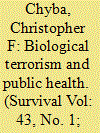

|
|
|
|
|
| Publication |
2001.
|
| Description |
p93-106
|
|
|
|
|
|
|
|
|
|
|
|
|
|
|
|
| 2 |
ID:
052433
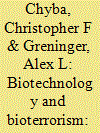

|
|
|
|
|
| Publication |
2004.
|
| Description |
p143-161
|
| Summary/Abstract |
The web of measures that comprise the nuclear non-proliferation regime continues to hold at bay the 'nuclear-armed crowd' that was part of President John F. Kennedy's alarming vision in 1963. The number of nuclear weapons states in 2004 stands at only eight or nine, and assertive steps may yet keep this number from growing. The proliferation of biological weapons, however, is quite another matter. Biotechnological capacity is increasing and spreading rapidly. This trend seems unstoppable, since the economic, medical and food-security benefits of genetic manipulation appear so great. As a consequence, thresholds for the artificial enhancement or creation of dangerous pathogens - disease causing organisms - will steadily drop. Neither Cold War bilateral arms control nor multilateral non-proliferation provide good models for how we are to manage this new challenge. Much more than in the nuclear case, civilisation will have to cope with, rather than shape, its biological future.
|
|
|
|
|
|
|
|
|
|
|
|
|
|
|
|
| 3 |
ID:
074540
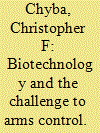

|
|
|
| 4 |
ID:
172904
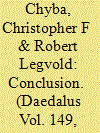

|
|
|
| 5 |
ID:
077380
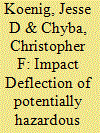

|
|
|
|
|
| Publication |
2007.
|
| Summary/Abstract |
Nuclear explosions, and a wide variety of technologies not yet realized, have been proposed to deflect asteroids away from collision with Earth. In contrast, this article presents realistic models for simple kinetic energy impact deflection, using the actual orbital elements of 795 catalogued Potentially Hazardous Asteroids, and impactor masses launched to intercept trajectories by Atlas V HLV rockets or equivalent. The authors take asteroid diameter, density, cratering characteristics, and Earth-collision lead time as parameters whose influence is to be investigated. Assuming asteroids of rocklike density, the article finds deflection off of Earth-collision to be achievable given 5-year lead time with a single kinetic energy intercept for 100% of 250 m diameter PHAs, 20-year lead with a single intercept for 93% of 500 m PHAs, 20-year lead with 5 and 10 intercepts, respectively, for 55% and 94% of 1 km PHAs, or 100-year lead with 1 and 2 intercepts, respectively, for 55% and 94% of 1 km PHAs. Considering likely future lead times for Near-Earth Objects, simple impact deflection using current launch vehicles is therefore a viable strategy for up to kilometer-diameter asteroids. This method has important advantages over other proposals: it requires no new technologies, would not require development or testing of nuclear warheads, and would likely be the least costly, least risky, and fastest to effect
|
|
|
|
|
|
|
|
|
|
|
|
|
|
|
|
| 6 |
ID:
172891
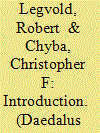

|
|
|
| 7 |
ID:
172900
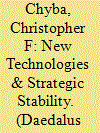

|
|
|
|
|
| Summary/Abstract |
A variety of new technologies, ranging from broad enabling technologies to specific weapon systems, may threaten or enhance strategic stability. In this essay, I analyze a technology's potential to significantly affect stability along three axes: the pace of advances in, and diffusion of, this technology; the technology's implications for deterrence and defense; and the technology's potential for direct impact on crisis decision-making. I apply this framework to examples including hypersonic weapons, antisatellite weapons, artificial intelligence, and persistent overhead monitoring. Formal arms control to contain dangers posed by some of these seems technically possible, though currently politically difficult to achieve. Others, particularly enabling technologies, resist arms control based on effective verification. The major powers will therefore instead have to find other ways to cope with these technologies and their implications. These options should include exchanges with potential adversaries so that pathways to nuclear escalation, and possible mitigating steps, can be identified and discussed.
|
|
|
|
|
|
|
|
|
|
|
|
|
|
|
|
| 8 |
ID:
057984
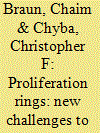

|
|
|
| 9 |
ID:
074873
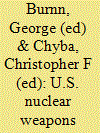

|
|
|
|
|
| Publication |
Washington, D C, Brookings Institution Press, 2006.
|
| Description |
xi, 340p.
|
| Standard Number |
0815713657
|
|
|
|
|
|
|
|
|
|
|
|
Copies: C:1/I:0,R:0,Q:0
Circulation
| Accession# | Call# | Current Location | Status | Policy | Location |
| 051898 | 355.02170973/BUN 051898 | Main | On Shelf | General | |
|
|
|
|
| 10 |
ID:
090342
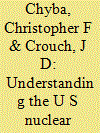

|
|
|
| 11 |
ID:
097107
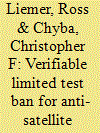

|
|
|
|
|
| Publication |
2010.
|
| Summary/Abstract |
The growing number of actors pursuing sophisticated outer space programs gives rise to one of the more novel challenges of the global commons. Once the privileged domain of the United States and the Soviet Union, space now accommodates a larger set of countries seeking to enhance their defense capabilities. In January 2007, perhaps most notably, China tested an anti-satellite (ASAT) missile, destroying Fengyun-1C, an old Chinese weather satellite. The weapon was a kinetic-energy ASAT, which homed in on its target and shattered it through high-velocity collision at an altitude of 864 km.1 The impact created thousands of debris fragments concentrated in orbits between 800 and 1,000 km,2 approximately doubling the risk of potentially catastrophic collision for satellites in the crowded 800-900 km range.3 Satellites at these altitudes include commercial communications satellites, a U.S. photoreconnaissance satellite, a Chinese earth science satellite, and a Russian electronic intelligence satellite.4 Most of the Fengyun-1C debris will stay in orbit for several decades; some is expected to remain in space for centuries.
|
|
|
|
|
|
|
|
|
|
|
|
|
|
|
|
|
|
|
|
|